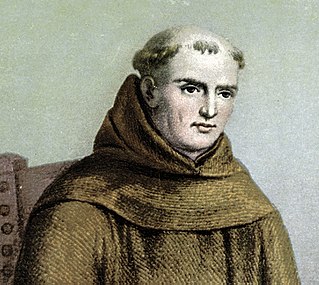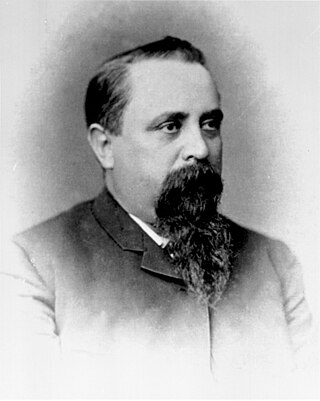
The Spanish missions in California formed a series of 21 religious outposts or missions established between 1769 and 1833 in what is now the U.S. state of California. The missions were established by Catholic priests of the Franciscan order to evangelize indigenous peoples backed by the military force of the Spanish Empire. The missions were part of the expansion and settlement of New Spain through the formation of Alta California, expanding the empire into the most northern and western parts of Spanish North America. Civilian settlers and soldiers accompanied missionaries and formed settlements like the Pueblo de Los Ángeles.

Mission San Gabriel Arcángel is a Californian mission and historic landmark in San Gabriel, California. It was founded by Spaniards of the Franciscan order on "The Feast of the Birth of Mary," September 8, 1771, as the fourth of what would become twenty-one Spanish missions in California. San Gabriel Arcángel was named after the Archangel Gabriel and often referred to as the "Godmother of the Pueblo of Los Angeles." The mission was built and run using what has been described as slave labor from nearby Tongva villages, such as Yaanga and was built on the site of the village of Toviscanga. When the nearby Pueblo de los Ángeles was built in 1781, the mission competed with the emerging pueblo for control of Indigenous labor.

Mission San Juan Capistrano is a Spanish mission in San Juan Capistrano, Orange County, California. Founded November 1, 1776 in colonial Las Californias by Spanish Catholic missionaries of the Franciscan Order, it was named for Saint John of Capistrano. The Spanish Colonial Baroque style church was located in the Alta California province of the Viceroyalty of New Spain. The Mission was founded less than 60 yards from the village of Acjacheme. The Mission was secularized by the Mexican government in 1833, and returned to the Roman Catholic Church by the United States government in 1865. The Mission was damaged over the years by a number of natural disasters, but restoration and renovation efforts date from around 1910. It functions today as a museum.

Mission San Fernando Rey de España is a Spanish mission in the Mission Hills community of Los Angeles, California. The mission was founded on 8 September 1797 at the site of Achooykomenga, and was the seventeenth of the twenty-one Spanish missions established in Alta California. Named for Saint Ferdinand, the mission is the namesake of the nearby city of San Fernando and the San Fernando Valley.

Mission San Luis Rey de Francia is a former Spanish mission in San Luis Rey, a neighborhood of Oceanside, California. This Mission lent its name to the Luiseño tribe of Mission Indians.

Fermín de Francisco Lasuén de Arasqueta was a Basque Franciscan missionary to Alta California president of the Franciscan missions there, and founder of nine of the twenty-one Spanish missions in California.

Saint Junípero Serra y Ferrer, popularly known simply as Junipero Serra, was a Spanish Catholic priest and missionary of the Franciscan Order. He is credited with establishing the Franciscan Missions in the Sierra Gorda, a UNESCO World Heritage Site. He founded a mission in Baja California and established eight of the 21 Spanish missions in California from San Diego to San Francisco, in what was then Spanish-occupied Alta California in the Province of Las Californias, New Spain.
José María de Zalvidea was a Spanish Franciscan missionary. He was born at Bilbao, Vizcaya, Spain, and became a Franciscan at the convent of San Mames, Cantabria, on 13 December 1798. He joined the College of San Fernando de Mexico in 1804 and became a missionary to the California Native Americans in August 1805.

The Spanish missions in Baja California were a large number of religious outposts established by Catholic religious orders, the Jesuits, the Franciscans and the Dominicans, between 1683 and 1834. The missionary goal was to spread the Christian doctrine among the Indigenous peoples living on the Baja California peninsula. The missions gave Spain a valuable toehold in the frontier land, and would also act as a deterrent to prevent pirates from using the peninsula of Las Californias as a jumping off point for contraband trade with mainland New Spain. Missionaries introduced European livestock, fruits, vegetables, and industry into the region. Indigenous peoples were severely impacted by the introduction of European diseases such as smallpox and measles; furthermore, the expulsion of the Jesuits from the Spanish Empire in 1767 ripped the social fabric of the peninsula, although Franciscans were sent to replace them. In 1769, the Franciscans moved to Upper California, leaving Dominicans in charge of Baja California. By 1800 indigenous numbers were a fraction of what they had been before the arrival of the Spanish, yet even today many people living in Baja California are of indigenous heritage.

Gerónimo Boscana was an early 19th-century Franciscan missionary in Spanish Las Californias and Mexican Alta California. He is noted for producing the most detailed ethnographic picture of a Native Californian culture to come out of the missionary period, an account that "for his time and profession, is liberal and enlightened".
Andrés Quintana, O.F.M. was a Roman Catholic Spanish priest and missionary of the Franciscan Order who labored at Mission Santa Cruz in California during the early part of the 19th century.

Father José Joaquin Jimeno was a Spanish missionary to the Americas.
Father Gregório Amúrrio, O.F.M. was a Catholic priest of the Franciscan Order, and a Spanish missionary in California during the 18th century. A member of the Franciscan Province of Cantabria, Spain, he was one of twenty Franciscans who set out from the missionary College of San Fernando de Mexico in October, 1770 to labor in the Spanish missions in Baja California.
Pablo de Mugártegui, O.F.M., was a Basque Catholic priest and friar of the Franciscan Order, and a missionary in California during the 18th century. Along with Father Gregório Amúrrio, Mugártegui was a member of the Franciscan Province of Cantabria before he joined the missionary College of San Fernando de Mexico.
Father Vicente Fustér, O.F.M. was Catholic a priest of the Franciscan Order, and a Spanish missionary in California during the 18th century. A member of the Franciscan Province of Cantabria, Spain, he was one of twenty Franciscans who set out from the missionary College of San Fernando de Mexico in October, 1770 to labor in the Spanish missions in Baja California. On November 24, 1771 he arrived at Loreto with fourteen of his colleagues. In the summer of 1773 the Franciscans surrendered all missions on the Baja Peninsula to the Dominicans, after which Father Amúrrio along with five other friars volunteered to work the new missions in Upper California. Upon arrival in San Diego on August 30, Fray Fustér was assigned to Mission San Diego de Alcalá to take the place of Father Tomás de la Peña.
Father José Barona, O.F.M. was a Catholic priest of the Franciscan Order, and a Spanish missionary in California during the late 18th and early 19th centuries. Born in July, 1764 at Villanueva del Conde, in the archdiocese of Burgos, Old Castile, Father Barona entered the Order of St. Francis at the Villa de Velorado in the Province of Burgos on July 18, 1783. He arrived at the missionary College of San Fernando de Mexico on August 24, 1795, and set out from there in 1798 to labor in the Spanish missions in California. Upon arrival in San Diego, Fray Barona performed his first baptism at Mission San Diego de Alcalá on August 4 of that same year.

Toviscanga was a former Tongva village now located at Mission San Gabriel Arcángel in San Gabriel, California. Alternative spellings for the village include Tobiscanga. The name of Tuvasak was the Payómkawichum name for the village. The village was closely situated to the village of Sibagna.
The California mission clash of cultures occurred at the Spanish Missions in California during the Spanish Las Californias-New Spain and Mexican Alta California eras of control, with lasting consequences after American statehood. The Missions were religious outposts established by Spanish Catholic Franciscans from 1769 to 1823 for the purpose of protecting Spain's territory by settlements and converting the Californian Native Americans to the Christian religion.

The Mexican Secularization Act of 1833, officially called the Decree for the Secularization of the Missions of California, was an act passed by the Congress of the Union of the First Mexican Republic which secularized the Californian missions. The act nationalized the missions, transferring their ownership from the Franciscan Order of the Catholic Church to the Mexican authorities.

The Sepúlveda family is a prominent Californio family of Southern California. Members of the family held extensive rancho grants and numerous important positions, including Alcalde de Los Ángeles, California State Assemblymen, and Los Angeles County Supervisor.












